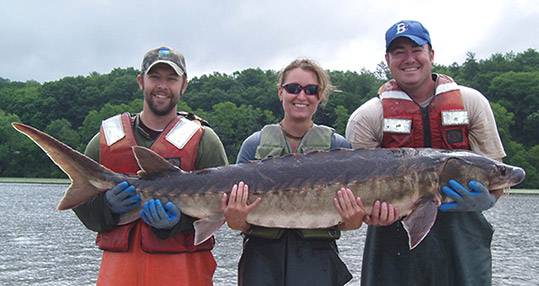Sturgeon
Two species of sturgeon are found in the Hudson: the Atlantic or sea sturgeon and the shortnose sturgeon.
The Atlantic sturgeon is anadromous; it spawns in fresh water but spends most of its adult life feeding and growing in the ocean. Young sturgeon may spend four years in the Hudson before migrating out to sea. When they return to spawn, males will be at least four feet long and twelve years old, females six feet long and fifteen years old. This sturgeon is the largest fish found in the Hudson, sometimes exceeding eight feet in length and two hundred pounds in weight.
The shortnose sturgeon tends to stay in the estuary. Adults are typically two to three feet long. The best way to tell the two species apart is not the length of the snout, but rather the width of the mouth. The mouth (inside the lips) is more than three fifths as wide as the distance between the eyes on a shortnose, less than three fifths on an Atlantic.

Historically these fish supported an extensive commercial fishery. Sturgeon meat was sold as “Albany beef” during the 1800s. However, overfishing and pollution reduced sturgeon populations. The shortnose is on the endangered species list (though the Hudson’s population, unlike those of other rivers, appears to be healthy). The river’s modern fishery for Atlantic sturgeon was closed in 1996, as scientists became worried about the scarcity of young sturgeon here. The Atlantic sturgeon population has stabilized, but it will be decades before it fully recovers.
Technically speaking, the sturgeon does not have a backbone. Its skeleton consists mainly of cartilage, not bone.



